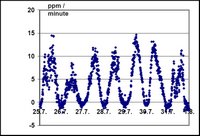Wednesday, August 02, 2006
Hiilidioksidin sieppaus edelleen vauhdissa - Carbon dioxide capture in full swing
 Kotovaaran kyvettimittaus osoittaa, että männyt sieppaavat hiilidioksidia (ks. Luontopäiväkirjan merkinnät 6.7.2006 ja 15.7.2006) heinäkuun lopussa edelleen täyttä vauhtia, vaikka sekä mäntyjen paksuus- että pituuskasvu ovat jo päättyneet tältä kasvukaudelta.
Kotovaaran kyvettimittaus osoittaa, että männyt sieppaavat hiilidioksidia (ks. Luontopäiväkirjan merkinnät 6.7.2006 ja 15.7.2006) heinäkuun lopussa edelleen täyttä vauhtia, vaikka sekä mäntyjen paksuus- että pituuskasvu ovat jo päättyneet tältä kasvukaudelta.Kun kyvetti on auki, sen sisällä olevassa ilmassa on normaali hiilidioksidin pitoisuus, mikä on keskikesällä noin 370 ppm. Kun kyvetti sulkeutuu ja on kiinni minuutin, kyvetissä oleva männyn oksa sieppaa kyvetti-ilmasta hiilidioksidia niin, että keskipäivällä pitoisuus putoaa noin 10 ppm:llä. Heinäkuun lopun jo hämärtyvässä yössä tilanne on päinvastainen. Männyn oksa hengittää, ja kyvetti-ilman hiilidioksidin pitoisuus nousee parilla ppm:llä (ks. oheinen graafi ylläolevan kyvetin mittaustuloksista heinäkuun viimeiseltä viikolta) .
 On edelleen osaksi arvoitus, mitä kaikkea mäntyjen loppukesästä sieppaamalle hiilidioksidille tapahtuu. Varastoituuko se vain hiilihydraatteina solunesteisiin odottaakseen seuraavan kevään kasvun purskahdusta, missä sokereita tarvitaan? Kuinka suuri osa siitä menee muina hiiliyhdisteinä maanesteeseen? Kuinka suuri osa emittoituu muina kaasumaisina hiiliyhdisteina (siis hiukkasina eli aerosoleina, ks. Luontopäiväkirjan merkintä 4.7.2006), takaisin ilmaan neulasten kautta, joko syksyllä tai seuraavana keväänä? Näitä kysymyksiä tutkitaan Smear-tutkimuksessa sekä Värriössä että Hyytiälässä.
On edelleen osaksi arvoitus, mitä kaikkea mäntyjen loppukesästä sieppaamalle hiilidioksidille tapahtuu. Varastoituuko se vain hiilihydraatteina solunesteisiin odottaakseen seuraavan kevään kasvun purskahdusta, missä sokereita tarvitaan? Kuinka suuri osa siitä menee muina hiiliyhdisteinä maanesteeseen? Kuinka suuri osa emittoituu muina kaasumaisina hiiliyhdisteina (siis hiukkasina eli aerosoleina, ks. Luontopäiväkirjan merkintä 4.7.2006), takaisin ilmaan neulasten kautta, joko syksyllä tai seuraavana keväänä? Näitä kysymyksiä tutkitaan Smear-tutkimuksessa sekä Värriössä että Hyytiälässä.(Hiilidioksidin sieppauksesta lisää, päivitys 7.8.2006)
The cuvette monitoring in Kotovaara of Varrio Subarctic Research Station shows that carbon dioxide capture by the young Scots pine trees keeps going at full swing (see the Nature diary blog posts of 6.7.2006 and 15.7.2006). This is the case even if both the height growth and diameter growth of the trees have reached their measurable maximum for this growing season.
When the cuvette is open (like in the photograph) the air inside it has the same carbon dioxide content as prevails in the outside air. In the middle of summer it is about 370 ppm. When cuvette closes, the branch inside starts to capture carbon dioxide from the cuvette air, as the needles continue assimilating. During one minute of cuvette closure the carbon dioxide content drops in the middle of the day by 10 ppm per minute. The drop is less earlier in the morning and later in the evening.
In the darkening night of end July the carbon dioxide flow is opposite. The needles respire, and this is seen as midnight negative values in the carbon dioxide capture graph. The total balance of positive values and negative values is clearly on positive side. Thus the branch of Scots pine in the cuvette is carbon dioxide sink as it removes carbon disoxide from the air.
It is still partly of mystery what happens to the considerable amount of carbon which is translocated to the trees, if the dimensions of the trees so no more grow in the latter half of the growing season. Is it just stored as soluble carbohydrates, or other organic molecules in the cells? After storin over winter these carbon rich compounds give power to the next spring and early summer growth.
How big part of the carbon-rich compounds is emitted through the roots into the soil water as soluble seed molecules for humus?
How about the emission of carbon-rich aerosols, back from needles to the atmosphere (see Nature Dairy blog post of 5 July 2006)? How much is this emission either in the subsequent autumn or in the spring? These questions are under Smear studies both in Varrio and Hyytiala.
More about carbon dioxide capture by Scots pine trees in here